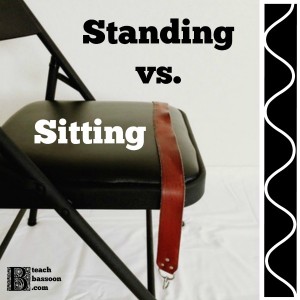 *UPDATE: See the end of the post for the product that finally got me standing
*UPDATE: See the end of the post for the product that finally got me standing
My students love watching bassoon videos on YouTube. It doesn’t take very many videos before they start asking me if they should be playing the bassoon standing up. I have never been really confident in my answer, as I tried the whole standing thing back in 2008, and it didn’t work for me. Fortunately, I recently stumbled upon a dissertation written about the ergonomics of bassoon playing—and there’s a section on standing!
The following paragraphs are excerpts and paraphrases from Noel A. Garcia’s dissertation titled The Ergonomics of Playing Bassoon: A Natural and Stress Free Approach to Playing the Instrument.¹
For playing standing up, Barrick Stees uses a balance hanger, shoulder harness, and a distance guard that he had installed on his instrument… Even with a balance hanger installed, the weight of the instrument can cause some pain on his left hand. However, through practice and conditioning he is able to play long enough without pain interfering with his performance.
For William Winstead, conditioning is an important step in preparing for performing standing up… Conditioning his body to play standing is a gradual process that allows his body to build up the necessary strength to compensate for the extra weight on his left hand, arm and back… Mr. Winstead uses a shoulder harness, but does not use a balance hanger, which causes the instrument to put significantly more weight on his left hand when playing standing up. Adjusting every few years to play standing up has been an easier solution for Mr. Winstead than trying to modify his instrument in any way.
David McGill feels that playing the bassoon in the standing position is like playing a whole different instrument. Two different bocals are needed with different bends to allow the proper embouchure for both the sitting and standing positions. This and others complications have convinced Mr. McGill that the bassoon is like the cello, an instrument that should be played only while sitting down.
See the full text of the dissertation for more information and pictures of the setups of William Winstead, Barrick Stees, and Martin James. (Institutional access to ProQuest is required.)
*UPDATE:After years of discomfort when I tried to play standing, I have finally found a product that allows me to stand and play with confidence. I still think sitting is fine, but if you really want to stand, you have got to try out the Jazzlab Saxholder. I use it with a balance hanger. Don’t let the name throw you off. It works great for bassoon (if you use the provided longer cord). If you don’t have a balance hanger installed, I recommend Mark Ortwein’s model. It doesn’t have to be installed with a drill.
¹Garcia, N. A. (2011). The ergonomics of playing bassoon: A natural and stress free approach to playing the instrument (Order No. 3490872). Available from ProQuest Dissertations & Theses Global. (917931454). Retrieved from http://search.proquest.com/docview/917931454?accountid=4488